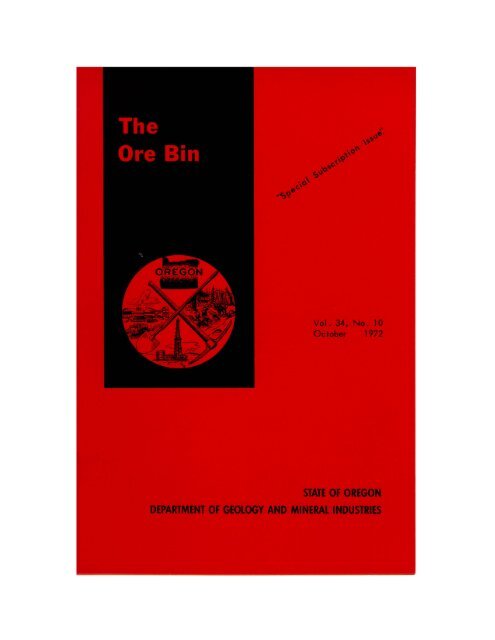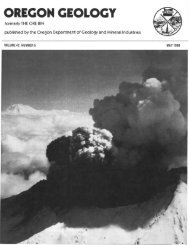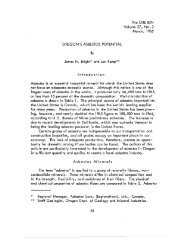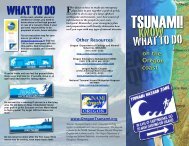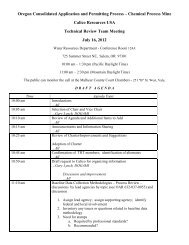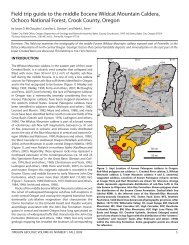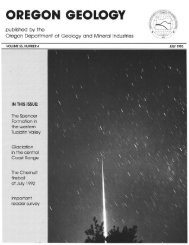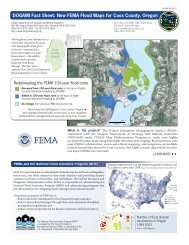Ore Bin / Oregon Geology magazine / journal - Oregon Department ...
Ore Bin / Oregon Geology magazine / journal - Oregon Department ...
Ore Bin / Oregon Geology magazine / journal - Oregon Department ...
You also want an ePaper? Increase the reach of your titles
YUMPU automatically turns print PDFs into web optimized ePapers that Google loves.
State of <strong>Ore</strong>gon<br />
<strong>Department</strong> of <strong>Geology</strong><br />
and Mineral Industries<br />
1069 State Office BI dg.<br />
Portland <strong>Ore</strong>gon 97201<br />
The ORE BIN·<br />
Volume 34,no. 10<br />
October 1972<br />
FOSSil SHARKS IN OREGON<br />
Bruce J. Welton*<br />
Approximately 21 species of sharks, skates, and rays are either indigenous<br />
to or occasionally visit the <strong>Ore</strong>gon coast. The Blue Shark Prionace glauca,<br />
Soup-fin Shark Galeorhinus zyopterus, and the Dog-fish Shark Squalus<br />
acanthias commonly inhabit our coastal waters. These 21 species are<br />
represented by 16 genera, of which 10 genera are known from the fossi I<br />
record in <strong>Ore</strong>gon. The most common genus encountered is the Dog-fish<br />
Shark Squalus.<br />
The sharks, skates, and rays, (all members of the Elasmobranchii) have<br />
a fossil record extending back into the Devonian period, but many major<br />
groups became extinct before or during the Mesozoic. A rapid expansion<br />
in the number of new forms before the close of the Mesozoic gave rise to<br />
practically all the Holocene families living today. Paleozoic shark remains<br />
are not known from <strong>Ore</strong>gon, but teeth of the Cretaceous genus Scapanorhynchus<br />
have been collected from the Hudspeth Formation near Mitchell,<br />
<strong>Ore</strong>gon.<br />
Recent work has shown that elasmobranch teeth occur in abundance<br />
west of the Cascades in marine Tertiary strata ranging in age from late<br />
Eocene to middle Miocene (Figures 1 and 2).<br />
All members of the EIasmobranchii possess a cartilaginous endoskeleton<br />
which deteriorates rapidly upon death and is only rarely preserved in the<br />
fossil record. Only under exceptional conditions of preservation, usually<br />
in a highly reducing environment, will cranial or postcranial elements be<br />
fossilized. The hard outer enamel of all sharks teeth enables them to resist<br />
weathering and transportation prior to deposition. Considering this fact and<br />
also the fact that tooth progression and replacement in the elasmobranchs<br />
is a perpetual process which continually contributes teeth to nearby sediments,<br />
it is no wonder that teeth constitute almost 100 percent of all the<br />
shark material found in <strong>Ore</strong>gon.<br />
* Student, <strong>Department</strong> of Earth Sciences, Portland State University<br />
161
Previous Work<br />
Although elasmobranch faunas from the Tertiary of <strong>Ore</strong>gon have never<br />
received extensive taxonomic treatment, their existence has, however,<br />
been noted by early workers, dating as far back as the mid-18oo's. In 1849,<br />
J. D. Dana explored the Astoria Formation in search of vertebrates and was<br />
one of the first to recognize shark remains from <strong>Ore</strong>gon.<br />
Packard (1940), in describing a leatherback turtle, Psephophorus(?)<br />
oregonensis, commented on the occurrence of sharks teeth in the Astoria<br />
Formation at the mouth of Spencer Creek. Packard (1947) again noted the<br />
presence of sharks teeth in the Astoria Formation, but unfortunately this<br />
material was never described.<br />
Steere, in a series of papers describing fossil collecting localities<br />
from the Tertiary marine sediments of western <strong>Ore</strong>gon, mentions the occurrence<br />
of sharks teeth from the Cowlitz Formation (1957) and again in a later<br />
publication (1958, p. 58) states that "0 few shark teeth have been collected<br />
from Oligocene marine sandstones of the Eugene Formation. II<br />
Sands of the Spencer Formatioo west of Monmouth, <strong>Ore</strong>gon, have<br />
yielded an unusually high concentration of shark and ray teeth of late<br />
Eocene age. Schlicker (1962, p. 174) noted this concentration, stating<br />
that "Sharks teeth are abundant in a roadcut near the Luckiamute River<br />
just north of Helmick Park on U.S. Highway 99-W • II<br />
The first shark remains from <strong>Ore</strong>gon to receive taxonomic tre atment<br />
were collected from Scoggins Creek by members of the <strong>Ore</strong>gon <strong>Department</strong><br />
of <strong>Geology</strong> and Mineral Industries -in 1967. Twenty-two vertebrae, one<br />
anterior tooth, and a few patches of calcified cartilage were collected from<br />
a well-bedded, fine-grained dark mudstone in the Yamhill Formation of<br />
Eocene Age. All of the specimens were forwarded for identification to<br />
Shelton P. Applegate, Associate Curator of Vertebrate Paleontology at the<br />
Los Angel es County Museum of Natural History. Shortly thereafter, an<br />
article appeared in The ORE BIN (Applegate, 1968) describing the dentition<br />
and skeletal elements as belonging to an Eocene Sand Shark Odontaspis<br />
macrota.<br />
Hickman (1969, p. 104) described the occurrence of two sharks teeth<br />
in the Eugene Formation, south of Salem, <strong>Ore</strong>gon. In her discussion she<br />
states, "Sharks teeth are occaionally found in the Eugene Formation. The<br />
teeth represent two major groups of sharks. The single cusps are typical of<br />
the modern galeoid type of shark (Hickman, 1969, pl. 14, fig. 12) and<br />
the saw-like teeth typical of the primitive hexanchoid genus Hexanchus<br />
(Notidanus) (Hickman, 1969, pl. 14, fig. 13). Both of these groups are<br />
abundantly represented by teeth in Tertiary mari"ne deposits, although they<br />
are not well known from the Pacific Coast."<br />
Specimens of the hexanchid sharks, Notorhynchus and Hexanchus,<br />
are relatively abundant in beds of lower Tertiary age in <strong>Ore</strong>gon. Sharks of<br />
the genus Notorhynchus are known from sediments of Eocene and Oligacene<br />
162
locality map for stratigraphic sections<br />
Southern Central Northern Southern<br />
Coast Coast Coast Willamette<br />
Epoch Range (1) Range (2) Range (3) Valley (4)<br />
u.J Port Orford<br />
Z<br />
u.J<br />
-<br />
U<br />
0 Empire<br />
-...J<br />
Fm.<br />
0-<br />
---<br />
u.J<br />
Z<br />
u.J<br />
U Miocene<br />
0 Beds<br />
~<br />
--<br />
Astoria<br />
Fm.<br />
----- Nye<br />
Scappoose<br />
LU<br />
Z<br />
Yaguina Fm.<br />
u.J<br />
U<br />
Pittsburg<br />
0<br />
Upper Bluff<br />
age in northwestern <strong>Ore</strong>gon, and early and middle Miocene beds of the<br />
central <strong>Ore</strong>gon Coast Range have yielded teeth of the Six-gilled Shark<br />
Hexanchus. The first North American occurrence of the genus Heptranchias<br />
is represented by a single tooth collected from the Keasey Formation at Mist,<br />
<strong>Ore</strong>gon.<br />
Occurrence<br />
Fine-grained black Cretaceous mudstones of the Hudspeth Formation<br />
crop out along numerous small exposures north of Mitchell in east-central<br />
<strong>Ore</strong>gon. These sediments have yielded three teeth, the only Mesozoic shark<br />
teeth known at this time from <strong>Ore</strong>gon. One of the teeth may be tentatively<br />
assigned to the common Cretaceous genus Scapanorhynchus. A more thorough<br />
search of these rocks will undoubtedly reveal an abundance of material.<br />
Five upper Eocene formations in western <strong>Ore</strong>gon have yielded elasmobranch<br />
remains, representing over 75 percent of all the Tertiary shark material<br />
known from <strong>Ore</strong>gon.<br />
The Yamhill Formation, cropping out along stream beds in Scoggins<br />
Valley, west of Forest Grove, <strong>Ore</strong>gon, has yielded a disarticulated skeleton<br />
of the Eocene Sand Shark, Odontaspis macrota (PI. 1, 30, b) (Applegate,<br />
1968). In association with this skeleton are five teeth of a yet undescribed<br />
species of echinorhinid or Spiney Shark (personal communication from<br />
Shelton P. Applegate). Apparently these teeth represent normal tooth loss<br />
during post-mortem scavenging by the Spiney Shark.<br />
Coarse sandstones and fine-grained mudstones of the Coaledo Formation,<br />
exposed from Yokam Point south to Shore Acres State Park below<br />
Charleston, yield many teeth, usually included in biostromes of clastic shell<br />
material. Over 700 shark and ray teeth have been recovered from sediments<br />
at Shore Acres State Park. This assemblage is characterized by Odontaspis<br />
macrota, Squalus, and the Eagle Ray Myliobatis (PI. 1, 8a, b, c). The<br />
abundance of myliobatid teeth at this locality far exceeds any other area<br />
in <strong>Ore</strong>gon.<br />
Sands of the Spencer Formation at Helmick Hill, 9 miles west of Monmouth,<br />
<strong>Ore</strong>gon contain a single discontinuous lens of weathered limonitestained<br />
pebbles and sharks teeth, not exceeding a foot in thickness. Disaggregation<br />
and screening of these sediments has yielded over 2,000 teeth,<br />
of wh ich 95 percent be long to the Sand Shark Odontaspis macrota. Teeth<br />
of Squalus, Myliobatis, Isurus, the Angel Shark Squatina, and the Horn<br />
Shark Heterodontus (PI. 1, 4c) are encountered.<br />
Transport prior to deposition at the Helmick Hill locality has destroyed<br />
the roots and severely abraded most of the teeth. Weathering and leaching<br />
by groundwater have also contributed to tooth destruction. Lateral edges<br />
and crown points on most teeth are smooth and rounded, and lateral denticles<br />
have been broken off most of the odontaspids. Only by the shear abundance<br />
of teeth is it possible to find a few specimens which still exhibit morphologic<br />
164
0<br />
0<br />
c<br />
0<br />
CO<br />
CII<br />
a.<br />
0<br />
.<br />
U<br />
E ...<br />
u.. 0<br />
. .<br />
. . . . ..... CII<br />
E :I<br />
E c -c '"<br />
E E E E u..<br />
. u.. .E . CII<br />
u.. E CO CII II><br />
E CO<br />
u.. u.. u.. 0 u.. -c<br />
Cl u.. Q)'<br />
0 N .... 0 '" :I<br />
- -C ... Q) 0 >-.<br />
...<br />
0<br />
0 C<br />
:I ~<br />
Q)<br />
...s; CII .- 0 :I Q)<br />
Sharks<br />
- ..0 a.<br />
c ...<br />
'"<br />
a. ... E ~ CII<br />
Q) 0<br />
'" Q) '" 0 .E 0<br />
0 0 0 a.<br />
Q) ... >-.<br />
0<br />
>- U U Vl Z ~ c... Vl z «'" ~<br />
Carcharodon X X X<br />
Centrophorus<br />
X<br />
Centroscymnus<br />
X<br />
Echinorhinus X<br />
Galeocerdo X X X<br />
Galeorhinus X<br />
Heptranchias<br />
X<br />
Heterodontus X X<br />
Hexonchus X X<br />
Isurus X X X X X X X<br />
Lamna X X X X X X ?<br />
Notorhynchus X X<br />
Odontaspis X X X X X X X X<br />
Pristiophorus X X X X<br />
Scyliorhinus X<br />
Sphyrna<br />
X<br />
Squalus X X X X X X X<br />
Squotino X X X X X X X<br />
Rays<br />
Myliobatis X X X X X<br />
Raja X X X<br />
Rhinoptera<br />
X<br />
Figure 2. Checklist of Tertiary Elasmobranchii from <strong>Ore</strong>gon.<br />
165
features suitable for description and identification. Unfortunately, less<br />
frequently occurring forms are usually quite abraded and classification beyond<br />
the generic level may be impossible for many. The probability also<br />
exists that these teeth were reworked from older underlying sediments.<br />
Explanation of Plate 1<br />
1. Notorhynchus sp. Agassiz (Seven-gilled SharkL Pittsburg<br />
Bluff Formation, Oligocene, lower left lateral tooth.<br />
X 2, PSU 13-17.<br />
2. Hexanchus sp. Rafinesque (Six-gilled Shark), Nye Mudstone,<br />
lower laterol tooth. X 1.B, Taylor collection, Portland,<br />
<strong>Ore</strong>gon.<br />
3. Odontaspis macrota Agassiz (Sand Shark), Yamhill Formation,<br />
second lower right anterior tooth; a. lingual view,<br />
b.lateralview. X 1.5, PSU 13-24.<br />
4. Heterodontus sp. Blainv. (Horn Shark), lateral pavement teeth,<br />
a. lateral view, b. dorsal view, both collected from the<br />
Quimper Sandstone, Washington; c. dorsal view of tooth<br />
collected from Spencer Formation, <strong>Ore</strong>gon. X 2.5, PSU<br />
13-1B and PSU 13-19.<br />
5. Squatina sp. Valmont (Angel Shark), Nye Mudstone,<br />
a. Lateral view, b. labial view. X 1.7, PSU 13-23.<br />
6. Pristiophorus sp. Muller and Henle (Saw Shark), Pittsburg<br />
Bluff Formation, rostral spine. X 1.7, PSU 13-22.<br />
7. Squalus sp. Linne (Dog-fish Shark), Pittsburg Bluff Formation.<br />
X 4.2, PSU 13-21.<br />
B. Myliobatis sp. Cuvier (Eagle Ray), Coaledo Formation, pavement<br />
tooth, medial row, a. ventral view showing roots,<br />
b. lateral view, c. dorsal view. X 2.2, PSU 13-20.<br />
166
POPULAR PUBLICATIONS ON OREGON GEOLOGY<br />
Descriptions of Some <strong>Ore</strong>gon Rocks and Minerals. .Miscellaneous paper no. 1 •... $ .40<br />
---<br />
Non-technical descriptions of commonly found rocks and minerals.<br />
Geologic Units: • . Geologic Formations of Western <strong>Ore</strong>gon Bulletin 70 •..••.•.......... 2 .00 ~<br />
Geologic Formations of Eastern <strong>Ore</strong>gon Bulletin 73 •.....•.......... 2.00<br />
Comprehensive references to formally named rock units in <strong>Ore</strong>gon: description, ---~<br />
distribution, contacts, lithology, age, references.<br />
...<br />
..2<br />
""0<br />
<strong>Geology</strong> of Selected Lava Tubes in the Bend Area, <strong>Ore</strong>gon. . Bulletin 71 ..••.••...••....•• 2.50 ~<br />
More than 20 lava-tube caves in the Bend area are mapped, described, illustrated.<br />
E<br />
Q)<br />
...<br />
<strong>Geology</strong> of Selected State Parks.<br />
. Each pamphlet $.25 .•....•• Total<br />
<strong>Ore</strong>gon's state parks have superb scenic attractions; the geology behind the scenery<br />
is illustrated and discussed: faults and folds, volcanism, fossils, age of rocks.<br />
Beverly Beach<br />
Cape Arago<br />
Cape Lookou t<br />
Cape Sebastian<br />
Collier<br />
Cove Palisades<br />
Ecola<br />
Florence<br />
Yachats<br />
Humbug Mountain<br />
Lake Owyhee<br />
<strong>Ore</strong>gon's "Moon Country" • Lunar Conference Guidebook - Bulletin 57 ................ 3.50 ~<br />
Five trips - illustrated with maps, diagrams, photos - through the volcanic area of ~<br />
central <strong>Ore</strong>gon used by lunar astronauts as geologic study area for walks on the moon.<br />
Gold and Silver in <strong>Ore</strong>gon. Bulletin 61 •.....••...•...•• 5.00<br />
A complete reference to occurrences in <strong>Ore</strong>gon. This reprinting of the original 1968 ---<br />
bulletin, which was out-of-print soon after publication, contains index maps of mining<br />
areas, production statistics, historical information, photographs.<br />
Q)<br />
...0<br />
A<br />
o<br />
E<br />
'" Q)<br />
C><br />
o<br />
0-<br />
""0<br />
..2<br />
...<br />
2
IMPORTANT NOTICE FOR ~<br />
ORE BIN SUBSCRIPTION NOTICE<br />
All subscriptions to The ORE BIN<br />
are now on a calendar year basis,<br />
January through December<br />
$2.00 per year<br />
$5.00 for three years<br />
Individual renewal reminder cards will no longer be<br />
sent to subscribers. A reminder to renew will be<br />
printed in The ORE BIN each Fall.<br />
ORE BIN RENEWAL FORM<br />
Enclosed is $<br />
___ years:<br />
----<br />
to extend my ORE BIN subscription for<br />
Name<br />
-----------------------<br />
Street<br />
----------------------<br />
City, State ______________ ZIP ______<br />
ii
II OR E BI N SUBSCRIBERS<br />
Rate:<br />
$2.00 per yearj $5.00 for three years<br />
Enclosed is $<br />
years to:<br />
NEW OR GIFT SUBSCRIPTION FORM<br />
• Please send The ORE BIN for<br />
---- ---<br />
Name<br />
------------------------------<br />
Street<br />
------------------------------------------<br />
City, State<br />
ZIP<br />
----------------------------- ------<br />
Enclosed is $<br />
years to:<br />
NEW OR GIFT SUBSCRIPTION FORM<br />
. Please send The ORE BIN for<br />
-------- -----<br />
Name<br />
---------------------------------------<br />
Street<br />
City, State<br />
ZIP<br />
--------------------------- ------<br />
Mail form{s) together with remittance to:<br />
The ORE BIN<br />
1069 State Office Building<br />
Portland, <strong>Ore</strong>gon 97201<br />
(Center fold pages may be removed for mailing)<br />
iii
Gold Panning for Fun. -', <strong>Ore</strong>gon's Gold Placers - Miscellaneo~papef no. 5 .25<br />
Where to go, how to pan, tests for gold and "fool's gold. II Plans for sluice boxes ---<br />
and rockers for the more seriou,s prospector.<br />
Stones From Outer Space. •••• • Miscellaneous paper no. 11 ••• 1.00<br />
Infonnation on identifying meteorites. Descriptions include the Port Orford stone, ---<br />
discovered 120 years ago but never relocated, and the Willamette stone.<br />
Mineral Deposits Mop of <strong>Ore</strong>gon. Mineral deposits mop and key.. .45<br />
Locations of 350 mines and mineral deposits on 22 1 x34" map with marginal descriptions;<br />
---<br />
placer mining areas shown on small mop. Key lists mineral localities.<br />
Where to Dig for Fossils in <strong>Ore</strong>gon. • • • •• ••.• Fossil articles ..•••••••••••• 1 .00 __ _<br />
A collection of 9 -pamphlets describing the more common fossils, their age, and where<br />
to dig for them, plus information on fossil wood.<br />
Index to The ORE BIN. • • • 1939-1948: Free. 1950-1969: Miscellaneous Paper no. 13 .30<br />
Some early issues of The ORE 81 N sti II avai lable - 10ti more recent issues - 25,t<br />
><br />
Postcards of geology of <strong>Ore</strong>gon, in color: • 10t each; 3 for 25,ti 7 for 50ti 15 for $1.00<br />
Please send the publications checked above to:<br />
Name __________________ ___<br />
Street<br />
----------------------<br />
Amount for publications $<br />
----<br />
Amount for ORE 81 N<br />
Total amount enclosed $<br />
----<br />
City, State<br />
ZIP<br />
Mail this form to:<br />
<strong>Ore</strong>gon <strong>Department</strong> of <strong>Geology</strong> and Mineral Industries<br />
1069 State Office Building, Portland, <strong>Ore</strong>gon 97201
1<br />
b<br />
,<br />
5<br />
•<br />
b<br />
... '~.-.<br />
~"\ ..... "" .• ~'f ~<br />
.....;.. ,<br />
. --~--'<br />
•<br />
b ,<br />
'"
Glauconitic green sands of the Nestucca Formation at Toledo yield<br />
fair to poorly preserved teeth of the Mako Shark Isurus, the Tiger Shark<br />
Galeocerdo, and what appears to be small teeth of the skate Raja. Mam-'<br />
malian bone fragments and teleost remains have also been found.<br />
A well-known Tertiary crinoid locality at Mist, <strong>Ore</strong>gon has contributed<br />
a number of smaller sharks from sediments of the Keasey Formation of<br />
late Eocene to early Oligocene age. Aside from such forms as Squatina,<br />
Odontaspis, the Seven-gilled Shark Notorhynchus, and Centrophorus, a<br />
new species of Seven-gilled Shark Heptranchias is being described from this<br />
locality by the author. Elsewhere the Keasey sediments have yielded a<br />
large and well-preserved tooth of the White Shark Carcharodon, Saw Shark<br />
Pristiophorus, and the Mako Shark Isurus.<br />
Coquina-like concretionary biostromes of clastic shell material which<br />
crop out along roadcuts in the lower sections of the Pittsburg Bluff Formation<br />
yield numerous teeth of a small squalid shark Centroscymnus and not uncommonly<br />
teeth of Raja, Squatina, Odontaspis, Squalus, Pristiophorus (PI. I,<br />
6), and Notorhynchus (PI. I, 1). These genera, plus several additidnal<br />
forms, collectively constitute the most diverse assemblage yet known from<br />
the middle Oligocene of <strong>Ore</strong>gon.<br />
Younger Oligo-Miocene sands of the Scappoose Formation, which conformably<br />
overlies the Pittsburg Bluff Formation, have produced teleost teeth<br />
and a fragmentary tooth crown of Squatina.<br />
Underlying the Astoria Formation at Newport and south toward Seal<br />
Rock are found sediments of early Miocene age which are assigned to the<br />
Nye Mudstone. A Six-gilled Shark Hexanchus (PI. I, 2), Squalus (PI. 1,<br />
7), Pristiophorus, Squatina (PI. 1, Sa, b), Odontaspis, and Isurus are found.<br />
This constitutes the only assemblage of eQrly Miocene sharks yet known from<br />
<strong>Ore</strong>gon.<br />
The Miocene Astoria Formation has extensive exposure along the <strong>Ore</strong>gon<br />
coast north of Newport, yet it has yielded only a few sharks teeth. This<br />
is quite surprising in light of the great abundance of teeth found in sediments<br />
of equivalent age from California and the Atlantic Coast of the United States.<br />
The assemblage at this time consists of the following: Carcharodon megalodon,<br />
Hexanchus, Myliobatis, Isurus planus?, and Galeocerdo d. aduncas. In<br />
addition, Dr. E. M. Baldwin of the University of <strong>Ore</strong>gon <strong>Department</strong> of<br />
<strong>Geology</strong> has in his possession a large tooth belonging to a Mako Shark,<br />
Isurus hastalis. This tooth was collected from sediments which were dredged<br />
up in Coos Bay and presumably are Miocene in age. Two Squalusteeth have<br />
also been collected from late Miocene sandstones immediately south of Cape<br />
Blanco, <strong>Ore</strong>gon.<br />
To my knowledge, teeth of sharks or rays have not yet been collected<br />
from Pliocene or Pleistocene sediments in <strong>Ore</strong>gon. This is not to say that<br />
they do not exist but only that very little attention has been directed towards<br />
searching for shark teeth in these sediments.<br />
168
Discussion<br />
It is difficult to identify unassociated fossil sharks teeth; to do so<br />
requires a thorough understanding of the variability of tooth morphology<br />
among species of modern sharks and rays. Teeth may be individually examined<br />
for the presence or absence of the following general features: crown<br />
and root shape; position of nutrient canals; serrations on the crown and<br />
dentic les; number of lateral denticles; tooth size; and flexures in the crown.<br />
Any number of these characteristics may require critical examination in<br />
order to segregate teeth of different species.<br />
Variations in tooth morphology may be observed within the jaws of<br />
almost any modern shark or ray. Teeth of a single species may differ in<br />
the upper and lower jaw or laterally in a single tooth row. Tooth variation<br />
also occurs as a result of age and sexual dimorphism. In order to establish<br />
valid taxa when working with unassociated fossil teeth, it is necessary<br />
to construct entire tooth sets which define the total range of variation within<br />
the species. This technique has proven to be useful for the interpretation of<br />
large faunas in California and is presently being applied to <strong>Ore</strong>gon sharks<br />
and rays.<br />
The paucity of some of the faunas previously described is for the most<br />
port apparent rather than real. It is due to the nature and conditions of<br />
deposition of the sediments and does not accurately represent the characteristics<br />
of the actual biotic community. The physical conditions of sedimentation<br />
and biologically limiting factors in the environment directly<br />
influence the resultant fossil assemblage. Where active transport or agitation<br />
of sediments occurs during deposition, organic remains may be subjected<br />
to severe abrasion, often resulting in the accumulation of clastic shell<br />
debris and total destruction of all softer parts. Sorting of teeth may occur<br />
as a result of strong current action, and post-depositional leaching by<br />
ground water can destroy tooth dentine. The latter best describes the conditions<br />
which must have existed during the formation of the Helmick Hill<br />
shark tooth bed. Only rarely do <strong>Ore</strong>gon localities yield nontransported<br />
shark material. However, excellent undisturbed faunas have been obtained<br />
from a few outcrops of the Coaledo, Nestucca, and Keasey Formations.<br />
Summary<br />
The purpose of this paper is to give some account of the fossil shark<br />
faunas of <strong>Ore</strong>gon. This has been, at best, only introductory to the more<br />
than 5,000 specimens now being studied by the author. Many of the genera<br />
are listed in Figure 2, but species determinations have not yet been completed.<br />
In most instances, more than one species exists for each genus listed.<br />
Newly developed localities are continuing to yield more material, and it is<br />
hoped that each of the faunas mentioned herein wi II be treated in full at a<br />
later date.<br />
169
A c know I edgm en ts<br />
Special thanks are expressed to Dr. Shelton P. Applegate, Los Angeles<br />
County Museum of Nat ural History, for the opportunity to study specimens<br />
of sharks at the Museum and for his assistance in the verification of t~e <strong>Ore</strong>gon<br />
material.<br />
I am also grateful to David Taylor of Portland, <strong>Ore</strong>gon, the. <strong>Ore</strong>gon<br />
Museum of Science and Industry, and the State <strong>Department</strong> of <strong>Geology</strong> and<br />
Mineral Industries for making their collections of Tertiary sharks teeth available<br />
for this study.<br />
Thanks are given to Dr. R. E. Thoms, Brian Gannon, Dr. Ronald<br />
Wolff, Margaret Steere, and Frank Kistner, who kindly read and criticized<br />
the manuscript. Photographic equipment was loaned by larry Chitwood,and<br />
the manuscript was typed by Chris Lewis.<br />
References<br />
Applegate, S. P., 1965, Tooth terminology and variation in sharks with<br />
special reference to the Sand Shark, Carcharias taurus Rafinesque:<br />
Contributions in Science, los Angeles County Museum, no. 86,<br />
p. 1-18.<br />
__-=....;' 1968, A large fossil Sand Shark of the genus Odontaspis from<br />
<strong>Ore</strong>gon: <strong>Ore</strong> <strong>Bin</strong>, v. 30, no. 2, p. 32-36.<br />
Beaulieu, John D., 1971, Geologic formations of western <strong>Ore</strong>gon: <strong>Ore</strong>gon<br />
<strong>Department</strong> of <strong>Geology</strong> and Mineral Industries, Bull. 70.<br />
Bigelow, H. B., and Schroeder, W. C., 1948, Sharks, skates and rays,<br />
in Fishes of the Western North Atlantic: Sears Found. Marine<br />
Research Mem. 1, Parts 1 and 2.<br />
Hickman, C. J., 1969, The 01 igocene marine molluscan fauna of the<br />
Eugene Formation in <strong>Ore</strong>gon: Museum of Natural History, Universityof<strong>Ore</strong>gon,<br />
Bull. 16, p.1-112.<br />
Packard, E. l., 1940, A new turtle from the marine Miocene of <strong>Ore</strong>gon:<br />
<strong>Ore</strong>gon State University, Studies in <strong>Geology</strong>, no. 2, p. 1-31.<br />
, 1947, A pinniped humerus from the Astoria Miocene of <strong>Ore</strong>gon:<br />
---=--'<br />
<strong>Ore</strong>gon State University, Studies in <strong>Geology</strong>, no. 7, p. 25-31.<br />
Steere, M. l., 1957, Fossil localities of the Sunset Highway area, <strong>Ore</strong>gon:<br />
<strong>Ore</strong> <strong>Bin</strong>, v. 19, no. 5, p. 37-44.<br />
, 1958, Fossil localities of the Eugene area, <strong>Ore</strong>gon: <strong>Ore</strong> <strong>Bin</strong>,<br />
----;<br />
v. 20, no. 6, p. 51 -59.<br />
Wilkinson, W. D., and Oles, K. F., 1968, Stratigraphy and paleoenvironments<br />
of Cretaceous rocks, Mitchell quadrangle, <strong>Ore</strong>gon: Amer.<br />
Assoc. Petrol. Geologists Bull. v. 52, no. 1, p. 129-161, 11 figs.,<br />
3 tables.<br />
* * * * *<br />
170
GEOLOGY I<br />
KEY SCIENCE IN RESOURCE AND ENVIRONMENTAL<br />
PROBLEMS<br />
Geological sciences are the key to understanding many of the problems<br />
related to resource development, land use, and the preservation of environmental<br />
quality, according to Dr. V. E. McKelvey, Director, U.S.<br />
Geological Survey, <strong>Department</strong> of the Interior.<br />
I n an address at Syracuse University, Syracuse, N.Y., McKelvey<br />
emphasized the urgency of advancing our knowledge about the earth and<br />
its resources. "In a physical sense," he said, "our life is dependent on the<br />
use we make of the earth and its resources."<br />
"Between now and the end of the century," he said, "we will need to<br />
build a Second America in the sense that we have to duplicate the entire<br />
U.S. plant -- factories, homes, highways, and hard goods."<br />
"We will need af least as much in the way of mineral and fuel<br />
resources in the next 28 years as we have used in all our previous history,"<br />
the Survey Director warned, noting also that "if we do not conduct our<br />
activities in an environmentally safe manner, we could do as much harm to<br />
the environment as we have done previously. In some areas of environmental<br />
stress, this might well mean that we would destroy the suitability of our environment<br />
for human habitation."<br />
"With our dependence on minerals and fuels," McKelvey said, "the<br />
consequences of failure to anticipate mineral shortages in time to make<br />
appropriate adjustments could well be catastrophic. And if, as some fear,<br />
potential resources are not adequate to support continued economic growth,<br />
considerable time would be required to bring about the economic and social<br />
changes necessary for our society to function at a far lower level of resource<br />
consumption without suffering economic collapse and perhaps social chaos."<br />
Noting that many doubt that we can long continue our accelerating<br />
use of resources, McKelvey cited a study (conducted at M.1. T. under the<br />
sponsorship of the Club of Rome) concluding that world resources would be<br />
exhausted in less than 100 years if we continue our exponentially increasing<br />
consumption, and that consequent growth in pollution and environmental<br />
damage wou Id be aqua lIy disastrous.<br />
"While I find much to commend in this study," McKelvey said, "I do<br />
not share fully in the conclusions, partly because they substituted assumptions<br />
about the magnitude of resources for knowledge of the potential, and<br />
partly because they did not allow for the effects of exponentially accelerating<br />
knowledge and ingenuity in creating resources and controlling the effects<br />
of their production and use. Nevertheless, the study shows clearly that we<br />
will have to scramble to meet future needs, and to preserve the viability of<br />
our environment."<br />
"In appraising these problems we need to substitute knowledge for the<br />
optimism or pessimism that is now the principal basis for speculation about<br />
man's future," McKelvey said.<br />
* * * * *<br />
171
COAST ENVIRONMENTAL GEOLOGY PUBLISHED<br />
Engineering geologists, stratigraphers, and ground-water specialists have<br />
collaborated in preparing the <strong>Department</strong>'s latest publication, Bulletin 74,<br />
"Environmental <strong>Geology</strong> of the Coastal Region of Tillamook and Clatsop<br />
Counties, <strong>Ore</strong>gon. II The authors are H. G. Schlicker, R. J. Deacon,<br />
J. D. Beaulieu, and G. W. Olcott.<br />
The bulletin and accompanying maps are designed primarily for county<br />
officials, planners, engineers, and private citizens concerned with future<br />
construction and development appropriate to the geologic character of the<br />
region. In this part of <strong>Ore</strong>gon, unstable bedrock, heavy rainfall, topographic<br />
extremes, and proximity to the ocean are inherent features that<br />
combine to produce geologic hazards such as landsliding, flooding, soft<br />
ground, wave erosion, and dune movement.<br />
The 164-page publication is abundantly illustrated by photographs<br />
and charts. Eighteen full-color maps in a se parate envelope illustrate engineering<br />
geology, geologic hazards, and degree of slope for each of six quadrang<br />
les. The report itself describes the geologic uni ts, engineering characteristics<br />
of each unit, economic mineral resources, and geologic hazards.<br />
A summary and recommendations and a glossary of technical terms are also<br />
included. Quarry sites, water-well logs, and other pertinent data are<br />
given in the appendix.<br />
Bulletin 74 and maps are for sale as a unit by the <strong>Ore</strong>gon Dept. of<br />
<strong>Geology</strong> and Mineral Industries at its Portland office. The price is $7.50.<br />
* * * * *<br />
DOLE OUTLINES GROWING RELIANCE ON MINERAL IMPORTS<br />
Hollis M. Dole, Assistant Secretary of the Interior for .Mineral Resources,<br />
recently outlined the degree to which the United States is becoming dependent<br />
on foreign supply sources for its mineral requirements. Speaking Oct. 3<br />
at an AIME meeting, Dole said, liThe gap between our supply and our<br />
demand (for minerals) has risen from $2 billion in 1950 to $8 billion in 1970<br />
and is projected to increase to $31 billion in 1985 and $64 billion in the<br />
year 2000." He based these figures on Interior's first annual report under<br />
the Mining and Minerals Policy Act of 1970.<br />
Among the problems that prevent the full potential of the nation's<br />
resources from being realized, Dole stated, are environmental constraints<br />
that have forced the closing of almost half the nation's zinc refining capacitYi<br />
the loss of markets by coal which is unable to meet sulfur content limitations;<br />
the denial of access or withdrawal from development of mineralized<br />
lands; and competition from other nations for access to foreign supplies.<br />
(American Mining Congress News Bull., Oct. 13, 1972)<br />
* * * * *<br />
172


